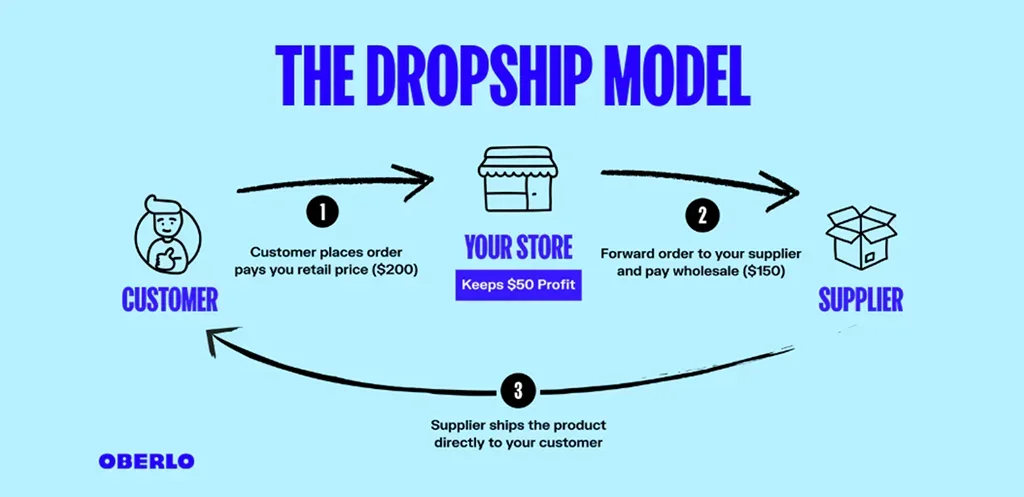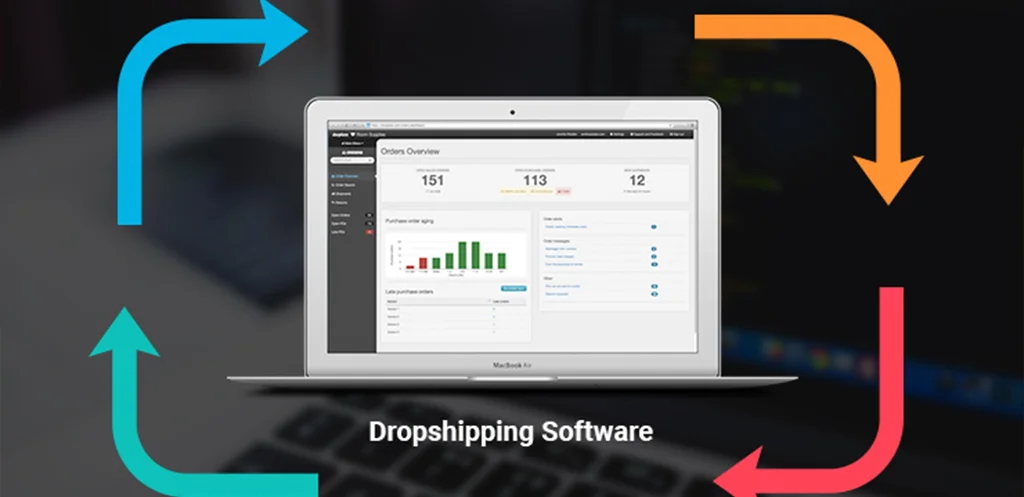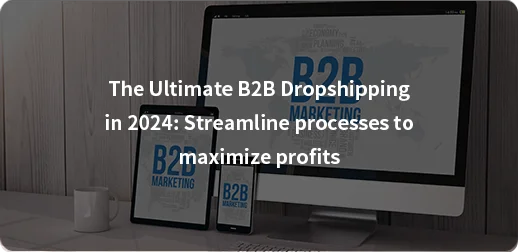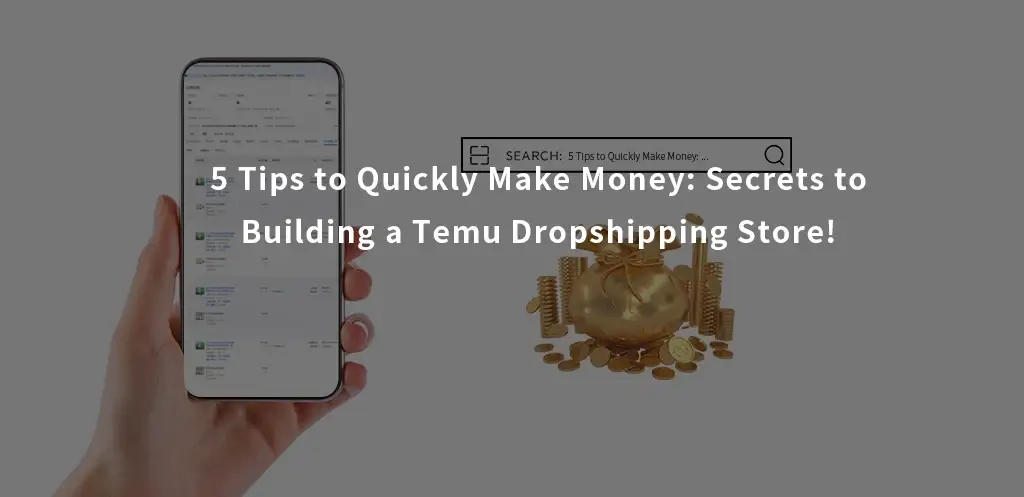B2B dropshipping is a business model that involves purchasing wholesale inventory from a third party who then ships the products to their buyers on your behalf. If you want to venture into ecommerce but aren’t quite ready for the logistics of manufacturing, warehousing, packaging, and shipping products, then dropshipping is an excellent starting point for you.
But how exactly does dropshipping work and what are some of the steps involved in launching a dropshipping store in 2024? Continue reading to find out as we go over the dropshipping workflow and several insights to have when building your own B2B dropshipping business.

The Power of Streamlined Processes
The impact of streamlined processes on dropshipping businesses cannot be overstated. By optimizing workflows and eliminating time wasted on unnecessary procedures, your business can experience benefits in several ways.
For example, streamlined order processing leads to increased efficiency and shorter delivery times. This not only improves customer satisfaction but it allows your business to handle increased order volumes without sacrificing quality whenever you need to scale.
Furthermore, streamlined processes lead to reduced costs as fewer resources are spent on inefficiencies and manual tasks, thereby allowing you to invest in areas that drive growth and revenue.
Streamline your processes with our cutting-edge platform, designed to simplify operations and boost profitability. Gain a competitive edge by maximizing efficiency, reducing costs, and delivering exceptional customer experiences.
How does B2B Dropshipping Works Step by Step?

Under the dropshipping business model, entrepreneurs sell products without having to physically stock them. When an order is placed, you simply forward it to your supplier, typically a wholesaler or manufacturer, who then sends it to the buyer. In detail, here’s a step-by-step overview of the procedures that go into setting up this kind of business.
Store Setup
Choosing your niche: Step one is identifying a specific market you want to focus on, such as clothing, machinery, kitchenware, gadgets, etc.
Building your online store: For this, use an ecommerce platform like Shopify or WooCommerce to design a professional-looking store and provide a user-friendly interface.
Collaborating with suppliers: This part involves finding and building relationships with suppliers that support dropshipping services. You can find them via platforms like Oberlo, SaleHoo, and AliExpress.
Product Selection and Pricing
Selecting products: Once you’ve identified your broad niche, it’s time to hone in on your product selection. Choose products from your suppliers’ catalog that fit your store’s theme.
Determining pricing: It’s time to decide on your pricing strategy. Put together your sourcing costs and overhead costs then determine the profit margin you wish to achieve i.e. 10%, 30%, etc. Once you have your sourcing costs and desired profit, add them up to obtain your retail prices.
Order Processing
Clients visit your store, place their orders, and pay the price you set. After receiving orders, it’s your job to forward customers’ orders, shipment details, and the wholesale cost to your supplier, although this process can be automated with certain apps and tools.
Payment Processing
Integrate a payment gateway into your ecommerce platform for automated and secure transactions.
Shipping
Direct shipping from supplier: With this method, your supplier ships the items directly to the buyer.
Customized packaging: On the other hand, some suppliers support branded packaging and shipping, meaning you can add finishing touches and enhance the unboxing experience.
Revenue and Profit Calculations
Once the sale is complete, your profit is the difference between your selling price and the wholesale price you paid your supplier.
Now that we have a rough understanding of the dropshipping workflow, let’s take a closer look at some of the advantages and disadvantages of this business model.
What Are The Advantages of B2B Dropshipping?
Low Initial Investment
A dropshipping business requires little to no upfront capital or inventory investments. This allows business owners to get started quickly with minimal financial risk.
Minimized Risk
Since buyers place orders directly with the manufacturer, the business owners don’t have to worry about unsold inventory. Dropshipping eliminates the risk of investing in inventory that doesn’t sell.
Automation
A dropshipping platform simplifies the order process, allowing business owners to quickly and efficiently fulfill orders. This allows owners to focus their attention and resources on other areas of their business.
Flexibility
Dropshipping allows business owners more flexibility when it comes to product selection and pricing. This can be beneficial in wooing potential clients and staying ahead of the competition.
Increased Profits
By keeping expenses low and capitalizing on economies of scale, business owners can effectively keep their costs down and increase their profits.
What Are The Disadvantages of B2B Dropshipping?
The biggest disadvantage of B2B dropshipping is the lack of control over the inventory and supply chain.
Since the product is purchased from the supplier and not stored in a warehouse, the dropshipper must rely on the supplier to stock and deliver the product properly. This can lead to delivery delays, out-of-stock items, canceled orders, and other issues that cannot be controlled within the business.
Additionally, the dropshipper is limited in the product options they can offer since they must adhere to what their supplier provides, which may not match up with customer expectations or trends.
Finally, the supplier holds ultimate control of the price, meaning that the dropshipper cannot engage in deep discounting or special offers that might draw customers away from another competitor.
How to launch a dropshipping store in 2024

From researching products to designing a functional website, evaluating potential suppliers, and considering marketing strategies, this section will explain how to put these parts of your dropshipping business in order.
Research & Choose Products
The success of a B2B dropshipping business depends on the type of products you choose. Make sure they have a good demand among businesses. You must also consider the competition and required investment. Here are a few tips to create an effective research process:
- Analyze products – Research the products in terms of demand, pricing, and competition.
- Identify profitable niches – Identify products with good potential and make a list.
- Identify wholesale suppliers – Search for reliable dropshipping wholesalers.
- Negotiate prices – Negotiate better prices from suppliers for better profits.
Choose A Dropshipping Platform
Choosing the right platform is the most crucial decision when starting a B2B dropshipping ecommerce business. The right platform will ensure scalability and provide features that are beneficial for your B2B business. Here is a list of features to look for in a dropshipping platform:
- Analytics & Reporting – These features provide insights into customer behavior, sales performance, and the overall success of your store.
- Inventory Management – Inventory management is essential to keep track of goods and their delivery.
- Order & Payment Processing – Order and payment processing should be swift and secure.
- Marketing & SEO Tools – Good marketing tools can help you to bring in more sales.
Create An Engaging Website
Your website should be designed for target customers and mobile users. Make sure it’s optimized for search engines and provides a seamless user experience. Here are a few elements your website should have:
- Product descriptions & visuals – Make sure you create adequate, detailed descriptions and high-quality product images.
- Index your website – This enables search engines to read and index your website.
- Add promotions & offers – Add promotions and offers to your website to engage customers and increase sales.
Where to Search for Suppliers

Once you complete these crucial first steps, it’s time to find a trustworthy supplier. During your search, you must emphasize trustworthiness because the quality of customer experience you provide depends on product quality and timely logistics. Below are some methods to find experienced suppliers:
- Use wholesale directories like Worldwide Brands, Oberlo, or SaleHoo. These directories offer access to vast networks of manufacturers and redistributors so you can find potential suppliers quickly.
- Search ecommerce marketplaces like Alibaba and DHgate to find potential suppliers in your niche. Compare prices, shipping times, and reviews from past buyers as you evaluate partners on these platforms.
- Attend trade shows and industry events to connect with suppliers in person and learn about their services. Trade events are an excellent place to identify potential partners as attendees have the shared goal of networking.
- Find products you want to sell, contact their manufacturers directly, and ask about their dropshipping services. Not all manufacturers or suppliers may agree to dropship, but many more will be willing to work with you.
Factors to Search for in the Right Suppliers
As you evaluate potential suppliers, you must consider factors such as product quality, shipping times and costs, minimum order quantities, and payment terms. To help you out, here are some detailed terms and factors to clarify when negotiating business terms with suppliers:
Product quality: Inspect the quality of your supplier’s inventory and compare them against competitors’ offerings in terms of durability and features or performance. By doing so, you can ensure the products you offer satisfy your standards and those of customers.
Competitive wholesale prices: After receiving a quote from potential suppliers, compare it against competitors to determine if it’s a competitive price. By optimizing costs (without sacrificing quality), you can serve your customers while maximizing profit margins.
Shipping and delivery times: Evaluate potential suppliers’ shipping times to ensure they can deliver products to customers on schedule. A good way to test this is by anonymously ordering a tiny shipment to undergo the experience your customers face if you choose that supplier.
Inquire about suppliers’ payment terms, such as the payment methods they accept, payment due dates, and processing fees if any.
Customer support: To guarantee a positive customer experience, you need to work with a dropshipping supplier that is responsive in case issues like late or delayed shipments arise. You may evaluate this by testing their responsiveness via support channels like email, calls, etc.
Inspect their catalog to ensure they have a wide variety of products in the same niche.
Clarify their return and refund policies, then communicate them to your customers.
Lastly, check reviews and testimonials from their past clients to gauge suppliers’ reputations.
Choosing Dropshipping Software

While dropshipping doesn’t require particular software in every case, leveraging the right systems and programs will help you streamline your processes to maximize profits. That being said, here’s a roundup of different software you might want to use when starting your dropshipping store:
eCommerce Platform
You’ll need an ecommerce platform to set up your store and host your product catalog, orders, and customer information. Look into popular and tested platforms like Shopify, WooCommerce, or BigCommerce.
Dropshipping Automation Tools
Dropshipping automation software streamlines many aspects of the dropshipping workflow such as order processing, inventory management, and package shipping. Popular dropshipping automation software includes Oberlo, Dropified, and Sprocket.
Customer Relationship Management (CRM) Software
CRM tools manage your customer information, including their purchase history, contact details, and communication preferences. Consider using CRM software like HubSpot, Salesforce, or Zoho CRM to enhance your customer relationships.
Payment Solutions
Payment processing software or gateway will help you securely process payments from shoppers. Payment solutions you might be familiar with include Stripe, Authorize.net, and PayPal.
Shipping and Logistics Software
Shipping and logistics software includes tools to manage shipping processes, such as label generation and shipment tracking. Popular solutions in this category are ShipStation, Easyship, and ShipBob.
Organic Marketing Strategies for Dropshipping

Marketing is a critical piece of the dropshipping puzzle. Given the nature of dropshipping (essentially promoting another business’s products), a well-planned marketing strategy can be the difference between having a thriving store and one that struggles to make sales.
In the following sections, we’re gonna explore several marketing insights directly related to dropshipping businesses.
Audience Research
Use tools like Google Trends and social media analytics suites to research your target audience’s needs, pain points, and preferences. Create detailed customer personas based on the data you gather to tailor your marketing materials and campaigns to specific segments of your audience.
Social Media Marketing
Consider what platforms your users are most active on. Develop a content strategy that engages your audience, including product demos, influencer promotions, and customer testimonials, based on the platforms resonating with your potential customers.
Search Engine Optimization (SEO)
Identify keywords your customers are searching for using tools like Ahrefs or SEMrush. Optimize your website titles, meta descriptions, and images by incorporating these keywords sufficiently to increase your search engine rankings.
Additionally, consider publishing helpful, high-quality content in your niche such as how-to guides, blog posts, and product reviews.
Email Marketing
Collect customer emails and use incentives like discounts or value content. Use email marketing automation tools to send newsletters, product updates, and personalized offers to your subscribers as your email list grows.
Want to learn more about what you can do with email marketing? Here’s 12 crucial emails to send for success with email marketing.
Conclusion
B2B dropshipping ecommerce is the future of ecommerce and has gained a lot of popularity in the last few years. The success of a dropshipping business depends on the products you select, the dropshipping platform you use, and the website you create.
Following this guide, you can easily set up a successful B2B dropshipping ecommerce business in 2024.
















